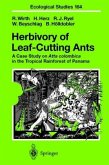The groundbreaking canopy-access and rain forest research at Lambir Hills National Park in Sarawak, Malaysia, has contributed an immense body of knowledge. Its major studies over more than a decade are synthesized here for the first time. The focus of this unique volume is on plant-animal interactions and some of the foundations that create and maintain tropical diversity, especially pollination and the phenomenon of the General Flowering. The work discussed has implications for tropical biology, ecology, and pollination studies. The power of the El Nino-Southern Oscillation events and drought, particularly in their effects on mutualisms, are discussed in detail.
Rain Forest Biology and the Canopy System, Sarawak, 1992-2002 The rain forest takes an immense breath and then exhales, once every four or ?ve years, as a major global weather pattern plays out, usually heralded by El Nin o-Southern Oscillation. While this powerful natural cycle has occurred for many millennia, it is during the past decade that both the climate of Earth and the people living on it have had an increasing in?uence on the weather pattern itself, with many biological consequences. In Southeast Asia, as also in most of the Neotropics, El Nin o accompanies one of the most exuberant o- pourings of nature's diversity. After several years of little activity, the incredibly diverse rain forests suddenly burst into ?ower-a phenomenon referred to as General Flowering in Asia. Plant populations are rejuvenated and animals are fed, but the process involves a delicate and complex balance. When the canopy access system was under construction at Lambir Hills - tional Park in the early 1990s, it made use of an underlying technology that was already in place: bridges. For centuries, bridges have spanned the natural chasms over rivers. This existing network of bridges and the people who built and use them produced the technology we needed to gain access to the canopy. Bridge builders were our natural allies in the quest for biological knowledge of the high canopy.
Hinweis: Dieser Artikel kann nur an eine deutsche Lieferadresse ausgeliefert werden.
Rain Forest Biology and the Canopy System, Sarawak, 1992-2002 The rain forest takes an immense breath and then exhales, once every four or ?ve years, as a major global weather pattern plays out, usually heralded by El Nin o-Southern Oscillation. While this powerful natural cycle has occurred for many millennia, it is during the past decade that both the climate of Earth and the people living on it have had an increasing in?uence on the weather pattern itself, with many biological consequences. In Southeast Asia, as also in most of the Neotropics, El Nin o accompanies one of the most exuberant o- pourings of nature's diversity. After several years of little activity, the incredibly diverse rain forests suddenly burst into ?ower-a phenomenon referred to as General Flowering in Asia. Plant populations are rejuvenated and animals are fed, but the process involves a delicate and complex balance. When the canopy access system was under construction at Lambir Hills - tional Park in the early 1990s, it made use of an underlying technology that was already in place: bridges. For centuries, bridges have spanned the natural chasms over rivers. This existing network of bridges and the people who built and use them produced the technology we needed to gain access to the canopy. Bridge builders were our natural allies in the quest for biological knowledge of the high canopy.
Hinweis: Dieser Artikel kann nur an eine deutsche Lieferadresse ausgeliefert werden.
From the reviews:
"This book is a compilation of more than 10 years of research on the ecology of the lowland dipterocarp forest of Lambir Hills National Park, Malaysia. ... Many chapters contain valuable data on dipterocarp forest ecology and phenology never published before. Additionally, the book contains an appendix on reproductive traits, floral characteristics, and pollinators of 270 plant species of Lambir Hills National Park, belonging to 73 families. The book is comprehensively written and is recommendable to anyone working in (paleo)tropical ecology, or pollination biology." (Niels Raes, Blumea, Vol. 51 (1), 2006)
"This book provides an overview of ... studies conducted in the Lambir Hills National Park in Malaysia. ... A notable feature of this edited volume is the comparative analysis of pollination systems in neotropical and paleotropical forests. ... Papers on pollination and phenology provide important insights to evolution and ecology of tropical rain forest trees and their pollen vectors. ... this volume considerably enriches our knowledge of not only pollination in the tropics, but also differences between the Old- and the New-World tropics." (Kamaljit S. Bawa, Ecology, Vol. 87 (7), 2006)
"This volume focuses on interactions between plants and animals. ... Many informative tables and carefully drawn figures ... colour photos and a glossary enrich this unique and useful book. ... I expect that this book will find many appreciative users ... . The authors can be congratulated for the immense variety of interesting details presented in this substantial work. The book is necessary for all scientists working in the field of Tropical Ecology, but it is also very useful for students." (Anselm Kratochwil, Phytocoenologia, Vol. 36 (3), 2006)
"This book is a compilation of more than 10 years of research on the ecology of the lowland dipterocarp forest of Lambir Hills National Park, Malaysia. ... Many chapters contain valuable data on dipterocarp forest ecology and phenology never published before. Additionally, the book contains an appendix on reproductive traits, floral characteristics, and pollinators of 270 plant species of Lambir Hills National Park, belonging to 73 families. The book is comprehensively written and is recommendable to anyone working in (paleo)tropical ecology, or pollination biology." (Niels Raes, Blumea, Vol. 51 (1), 2006)
"This book provides an overview of ... studies conducted in the Lambir Hills National Park in Malaysia. ... A notable feature of this edited volume is the comparative analysis of pollination systems in neotropical and paleotropical forests. ... Papers on pollination and phenology provide important insights to evolution and ecology of tropical rain forest trees and their pollen vectors. ... this volume considerably enriches our knowledge of not only pollination in the tropics, but also differences between the Old- and the New-World tropics." (Kamaljit S. Bawa, Ecology, Vol. 87 (7), 2006)
"This volume focuses on interactions between plants and animals. ... Many informative tables and carefully drawn figures ... colour photos and a glossary enrich this unique and useful book. ... I expect that this book will find many appreciative users ... . The authors can be congratulated for the immense variety of interesting details presented in this substantial work. The book is necessary for all scientists working in the field of Tropical Ecology, but it is also very useful for students." (Anselm Kratochwil, Phytocoenologia, Vol. 36 (3), 2006)








